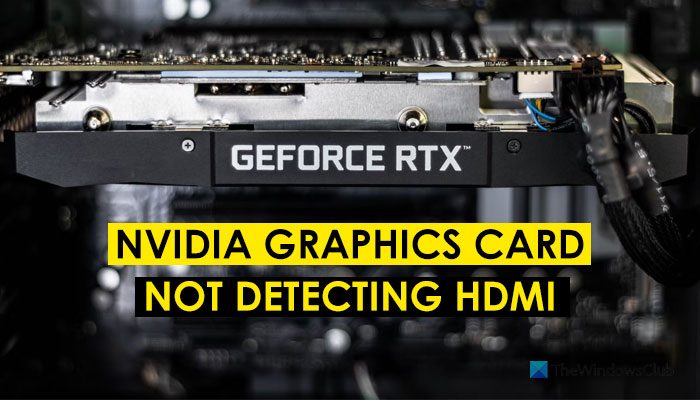Most NVIDIA graphics cards some with either HDMI+DVI-D, HDMI+HDMI, or HDMI+VGA port combination. Whether you use an aged or modern-day graphics card, there is a high chance that it comes with an HDMI port. However, this port may not work if you have been using it for a very long time due to many reasons. In such situations, you could follow this guide.
NVIDIA graphics card not detecting HDMI
If NVIDIA graphics card is not detecting HDMI monitors on Windows 11/10 computer systems, follow these suggestions: To learn more about these steps, continue reading.
1] Verify HDMI cable and port
It is probably the first thing you need to check when your graphics card is not detecting the HDMI device. Whether it is NVIDIA or any other company, you must start the troubleshooting process with this step. If your cable is faulty, you will end up wasting your time if you follow other methods first. You can verify that by using it with another computer. Maybe you can take it to the local computer store, and ask for professional help. Not only the cable, but also it is mandatory to check if the HDMI port on your monitor is fully functional or not. The process is the same. You need to connect it to another computer with an HDMI cable. Pro Tip: Many people use a converter in order to use the HDMI port. For example, if you have a VGA to DVI-D cable and a free HDMI port, you can simply use a DVI-D to HDMI convert to make use of the free port. However, that may create problems. If the converter doesn’t work correctly or support your cable, you won’t receive any signal on your monitor.
2] Choose HDMI option manually
Most monitors allow users to choose between various sources, including HDMI, DVI-D, etc. By default, most of them select the options as you connect the respective cable. However, if your monitor doesn’t do that automatically, and it is set to DVI-D or VGA, you won’t be able to use HDMI. That is why it is recommended to choose the HDMI option manually. Even if your computer is not getting any signal, you can use the physical buttons to choose the option. These are the two things you can do without getting any signal through the HDMI cable. However, if you have another monitor or cable to connect to a monitor via DVI-D or VGA port, you can follow the rest of the solutions.
3] Change screen resolution
If you have an old monitor, you cannot force it to use a different screen resolution than the default one. For example, it supports 1366 x 768 pixels, and you selected 1920 x 1080 pixels. In such situations, some aged monitors might not be able to comply with such a setting. That is why it is recommended to use the original screen resolution.
4] Change Scaling
It is another setting that might cause the same problem on your computer. Old monitors do not always support high or lower scaling due to various restrictions. In such situations, you may end up getting nothing on your screen. That is why it is recommended to use the default scaling setting. The best thing is that you can change scaling using NVIDIA Control Panel. For that, open the NVIDIA Control Panel and go to Display > Adjust desktop size and position section. From here, choose the Aspect ratio option from under the Select a scaling mode.
5] Install or update driver
If you have Windows 11 or Windows 10, you might not need to install the graphics driver in order to use a dual monitor setup. However, the driver makes things smoother and lets you control various things related to the graphics card. That is why it is recommended to install the graphics driver. However, if you have already installed it earlier, you may want to update the graphics driver.
How do I enable HDMI on NVIDIA?
There is almost nothing you can do to enable or turn on the HDMI functionality on an NVIDIA graphics card. For your information, it is enabled by default. However, you can install the corresponding graphics driver on your computer.
How do I fix my GPU HDMI port not working?
If the GPU’s HDMI port is not working on working on your computer, you need to follow the aforementioned guides. You can start by checking the cable and ports. Secondly, you can choose the HDMI option manually, change screen resolution, adjust the scaling settings, etc. Last but not least is updating the driver. However, if nothing works, it is time to take the graphics driver to the service center. That’s all! Hope this guide helped.

